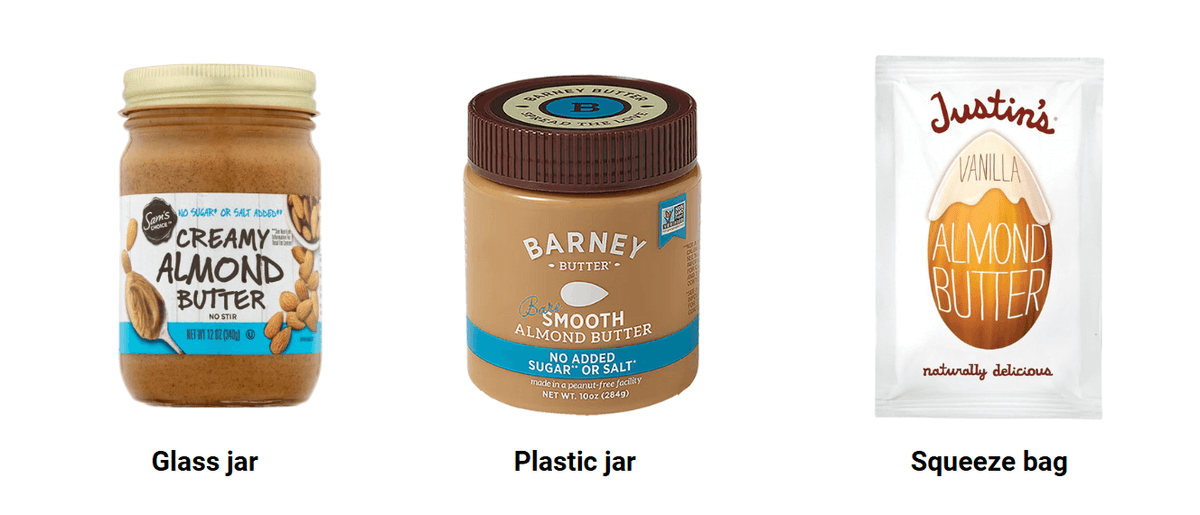Almond butter is extremely popular in Europe and the United States. Unlike peanut butter, which often contains stabilizers, high-quality almond butter adheres to a "100% natural" clean label positioning and typically contains no palm oil, emulsifiers, or preservatives. Precisely because of the lack of stabilizers, almond butter is prone to oil-to-salt separation , requiring laborious stirring to reconstitute the paste , significantly impacting the consumer experience. Packaging technology can significantly mitigate these issues without changing the recipe.
Common packaging types for almond butter
The form of almond butter packaging will directly affect the shelf life and consumer experience.

- Glass jars are the most common form of packaging . They offer excellent barrier protection, a premium appearance, and are widely trusted. However, they are heavy, fragile, and relatively expensive to ship .
- Plastic jars (PET or PP) are lighter, more shatter-resistant, and adapt well to modern processes such as nitrogen flushing. This makes them more suitable for large-scale distribution where cost and efficiency are key.
- Squeeze bags are a new trend . They allow consumers to squeeze almond butter directly without stirring. They're ideal for young people, those working out, and parents with children, focusing on convenience.
Advantages of different packaging forms
Each packaging format has its own unique advantages. Glass jars convey quality and create a high-end image. Plastic jars are economical and suitable for supermarkets and e-commerce
platforms. Squeeze bags solve the problem of "difficult to stir" and are very convenient . Other packaging formats are also possible .
1. Piston filling machine
Working Principle :
The machine resembles a large syringe, with a piston pumping through a cylinder to first extract a measured amount of product and then push it into the container below. It is ideal for handling highly viscous, easily separated products while ensuring accurate filling quantities . Due to the unique characteristics of almond paste, the filling machine incorporates a stirring element to continuously and gently agitate the paste to prevent particle sedimentation and stratification.
Application: Suitable for filling glass and plastic jars. Although the two containers are made of different materials, their shapes are similar. Therefore, the same type of filling machine can be used, only parts need to be changed to accommodate different container sizes.
2. Pouch packaging machine
Workflow :
- Bag making : Form the roll film into a three-dimensional bag.
- Filling : Almond paste falls from the hopper above the machine. A piston-type metering cylinder accurately extracts a certain amount of paste and then injects it into the film cylinder below which is continuously moving downward through the feeding port.
- Vacuum & Nitrogen Filling : After filling and before capping, the nitrogen filling system will evacuate the air and immediately inject nitrogen, and then quickly seal the bottle. This greatly delays oxidation and oil separation.
- Sealing and cutting : heat sealing is completed and individual bags are cut from the roll film.
Advantages : High degree of automation, from film rolling to finished product in one go, high efficiency and good preservation effect.
3. Other forms
Although less common, almond paste is also available in other packaging.
Tube packaging : Almond paste is packaged in tubes using a tube filling and sealing machine . The machine automatically loads the empty tube, fills it (usually with a precision piston), and then uses a "pliers" to fold the tube end and press it shut.
Easy-Snap packaging: This is our innovative device. It's compact and portable, and can be opened with one hand. It can be used for both liquids and powders.
Optimize packaging process to reduce oil separation
The first step is gentle in-line stirring before filling . A low-speed agitator keeps the oil and solids evenly distributed without creating heat or air bubbles. This ensures the almond paste remains homogeneous before being filled into jars or bags.
The second step is nitrogen flushing . Nitrogen displaces oxygen in the container, slowing oxidation and preventing surface oils from spoiling. This preserves the fresh almond flavor and extends shelf life.
The third step is choosing the right filling machine . For high-viscosity products like smooth almond paste, piston fillers are best suited. Crunchy almond paste with inclusions requires an auger or drill filler to prevent clogging. Advanced filling machines also feature anti-drip and back-sucking features to keep containers clean.
Finally, temperature and seal control are crucial. Filling at the right temperature improves flow, while a secure seal prevents oxygen from re-entering. These measures work together to minimize post-packaging separation.
Frequently Asked Questions and Answers
Do squeeze bags separate faster than cans?
Not necessarily. The difference lies primarily in how the consumer interacts with the product – a squeeze pouch allows for immediate access, so even slight separation is less noticeable.
Does nitrogen filling affect the taste?
No. Using food-grade nitrogen preserves natural flavors while maintaining freshness.
For almond paste manufacturers, oil separation presents both a technical and commercial challenge . Consumers want ready-to-eat products, not ones that require mixing. Through gentle mixing, nitrogen flushing, and precision filling , manufacturers can reduce oil separation, minimize complaints, and enhance brand loyalty while maintaining the product's natural character.
LTPM CHINA specializes in packaging machines for almond paste and other high-viscosity products. From pilot production to turnkey production lines, our solutions can help you produce consistent , superior almond paste packaging .
Contact us today to discuss your project and learn how our equipment can increase your productivity.


